This article was medically reviewed by Shari Forschen, NP, MA. Shari Forschen is a Registered Nurse at Sanford Health in North Dakota. Shari has worked in healthcare since 1996 and her expertise lies in acute care bedside nursing on a medical oncology floor. She received her degree from Medcenter one College of Nursing in 2003 and her Family Nurse Practitioner Masters from the University of North Dakota in 2014. Shari is a member of the American Nurses Association.
There are 11 references cited in this article, which can be found at the bottom of the page.
This article has been viewed 106,078 times.
Experts agree that a butterfly rash (also called a malar rash) is a flat, red rash that spreads from your nose down onto both cheeks evenly, resembling a butterfly's wings. Generally, it's a symptom of lupus erythematosus (LE), an autoimmune disease.[1] Research suggests that eczema (atopic dermatitis) produces dry, itchy, red, and cracked patches of skin, which can occur on your face.[2] Having a rash on your face is super frustrating, so you likely want to know what's causing it. While examining your rash may help you identify the cause, it's best to check with your doctor to get a proper diagnosis.
Steps
Examining the Rash
-
1Look at the rash. Eczema and butterfly rash have different characteristics which will help you distinguish between the two:[3] [4] [5]
- Eczema is a condition in which patches of skin become red, itchy, dry, cracked and sore. It can occur anywhere on your body but it is most common in areas where your skin forms creases, such as your hands and fingers, the insides of your elbows, the backs of your knees, and your face and scalp. As it heals your skin may be temporarily discolored.
- Butterfly rash is named this because it often forms the shape of a butterfly, running from the bridge of the nose to both cheeks. It is red, raised, and may be scaly, itchy or painful. The rash may also appear on other areas of the face or the wrists and hands. However, it usually does not cover the nasal folds. Your nasal folds are the areas under the sides of your nose.
-
2Evaluate what triggers the rash. Eczema and butterfly rash have different triggers. Understanding what brings on each type of rash may help you to differentiate them.[6] [7]
- Eczema is often triggered by irritants like soaps, detergents, or other chemicals, environmental influences like cold, dry weather, or humidity, allergens like dust mites, pet fur, pollen or mold, food allergies such as milk, eggs, peanuts, soy or wheat, allergies to fabrics like wool or synthetics, or hormonal changes in women during their cycle or during pregnancy.
- The butterfly rash may appear without an obvious trigger or after you are exposed to sunlight. If this is the case, you should see a physician, as this may be a sign of lupus.
Advertisement -
3Consider whether you have other symptoms. Butterfly rash is itself a symptom of lupus, while eczema is not a symptom of an underlying condition.
- People with eczema often also have allergies, hay fever, asthma, or a family member with these conditions.
- People with butterfly rash generally have other symptoms of lupus which may flare up at times. These symptoms include exhaustion, fever, sensitivity to the sun, chest pain, headaches, confusion, memory loss, difficulty breathing, dry eyes, joint pain and swelling, or fingers and toes that turn white or blue in reaction to stress or cold.
Getting Medical Attention
-
1Go to the doctor if you have an unexplained rash. If you are unsure whether your rash is eczema or butterfly rash, the doctor will examine you and diagnose the rash. It is especially important if:[8]
- You have other symptoms that could be signs of an underlying illness such as lupus. In order for lupus to be diagnosed, however, you will need lab work and other testing from your physician.
- You have a rash that shows signs of infection, such as weeping pus, red streaks, yellow scabs, or increasing pain and swelling.
- Your skin is so painful or itchy that it interferes with your ability to live your life or to sleep at night.
-
2Prepare for your doctor’s appointment. By preparing ahead of time you can make sure to get the most out of your appointment, both in terms of what information you want from the doctor and what information you want to remember to tell the doctor. Lupus can have symptoms that are similar to other conditions, so if the doctor suspects lupus, you may need to also go to a specialist to verify the diagnosis.[9] [10]
- Make a list of questions you have for the doctor. You may want to ask the doctor how long the rash may take to heal, whether there are any self-care techniques that are recommended, or if treatment is needed.
- Prepare a list of the symptoms you experience, when they started, and how often they happen.
- Bring a list of all prescription medications, over-the-counter medications, natural remedies, supplements, vitamins and herbs that you are taking. Write down how much you take and when. If it is easier, you can also bring the pill bottles and show the doctor. It is important for the doctor to have this information to determine whether your rash could be a response to anything you are taking. In addition, if the doctor prescribes you any other medication, he or she needs to be sure that it won’t interact with anything else you take.
-
3Allow the doctor to run tests if necessary. If you have eczema, the doctor will likely diagnose it by looking at the rash and asking about your medical history. If he or she suspects that you have a butterfly rash, you may need to do several other tests to determine whether you have lupus. There is no specific test for lupus, but depending upon your symptoms, these tests may help the doctor gather the information needed to make a diagnosis:[11] [12]
- Blood and urine analyses to determine how well your kidneys and liver are functioning.
- A chest X-ray. This would help determine whether your lungs have fluid or inflammation, as may occur in lupus.
- An echocardiogram. This test uses sound waves to produce images of your heart. It would enable your doctor to look for damage that might have occurred due to lupus.
References
- ↑ https://www.ncbi.nlm.nih.gov/pmc/articles/PMC3532807/
- ↑ https://www.nhs.uk/Conditions/Eczema-%28atopic%29/Pages/Introduction.aspx
- ↑ http://www.hopkinslupus.org/lupus-info/lupus-affects-body/skin-lupus/
- ↑ http://www.nhs.uk/Conditions/Lupus/Pages/Symptoms.aspx
- ↑ http://www.nhs.uk/Conditions/Eczema-%28atopic%29/Pages/Symptoms.aspx
- ↑ http://www.nhs.uk/Conditions/Eczema-%28atopic%29/Pages/Causes.aspx
- ↑ http://www.hopkinslupus.org/lupus-info/lupus-affects-body/skin-lupus/
- ↑ http://www.mayoclinic.org/diseases-conditions/lupus/basics/symptoms/con-20019676
- ↑ http://www.mayoclinic.org/diseases-conditions/eczema/basics/preparing-for-your-appointment/con-20032073
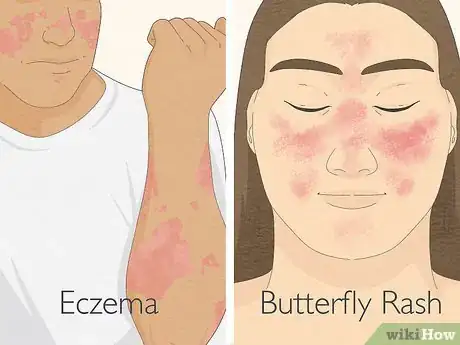

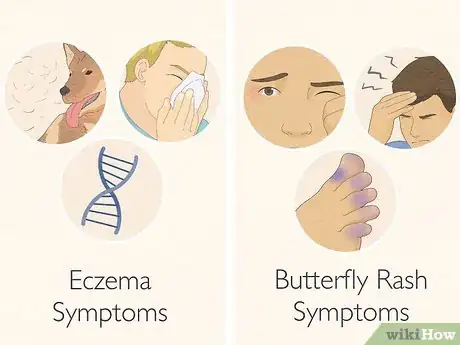
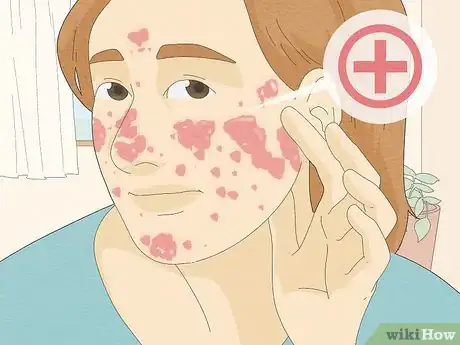

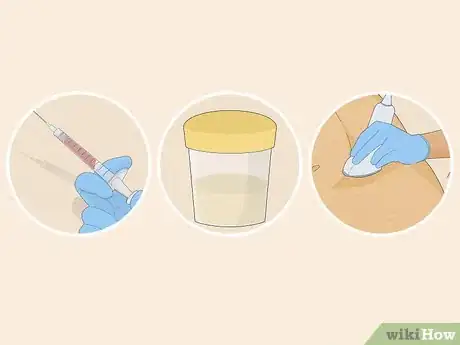





-Step-14.webp)
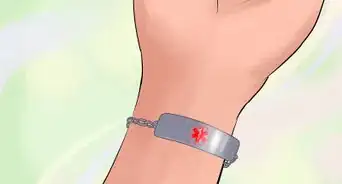
















































Medical Disclaimer
The content of this article is not intended to be a substitute for professional medical advice, examination, diagnosis, or treatment. You should always contact your doctor or other qualified healthcare professional before starting, changing, or stopping any kind of health treatment.
Read More...